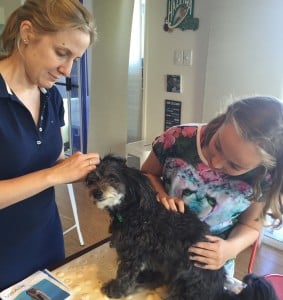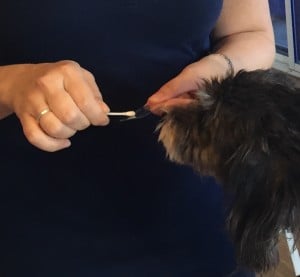Little Rose has had itchy ears on and off the last couple of days. Occasionally she’s had ear troubles in the past, but nothing too substantial. A quick squizz by her human parents didn’t reveal any manky discharges, but she still carried on scratching…
I went over to check little Rosie out and found despite her our outer ears not seeming too bad, her ear canals were quite red and sore. A quick sample smear from each revealed she had a yeast infection – when stained and visualised under the microscope they look a bit like miniature purple butternut pumpkins.
So why has Rosie got these little critters growing in her ears?
Yeast is actually part of the normal microflora of the skin. However, when something causes an imbalance in the skin’s natural defences, they multiply out of control and cause associated symptoms of itching, scratching, licking and chewing of ears and feet in particular. Occasionally generalised infections involving the whole body can occur. Yeast infections are relatively common in dogs with very hairy ear canals and big floppy ears that don’t allow the canals to dry out properly, especially in humid climates like south east Queensland. They also occur in animals that have skin allergies or sensitive skins that are more predisposed to infections. They like growing in moist, warm, dark places, so once an infection starts, the animal starts to lick and scratch which makes it more moist and favourable and so a vicious cycle of licking, chewing and growing yeast begins…
So what can be done to stop it?
Once examined and diagnosed by a vet using a smear and microscopic exam, it can be treated using special ear drops or shampoo depending on whether the infection involves just the ears, feet or whole body. The ear treatment lasts a minimum of 10 days with a follow-up check required 2 days later to make sure the infection has cleared up. If it involves the feet or rest of the body, treatment may last as long as 6 weeks, depending on the severity, with several checks required to make sure no secondary bacterial infections are starting up at the same time. If particularly bad, oral medication may also be required.
What can be done to prevent further infections?
Because yeast infections are usually secondary to an underlying problem, preventative efforts should be focused on making the skin environment as healthy as possible which reduces the severity and frequency of infections. Omega 3 fatty acids certainly help in reducing inflammation in the skin and improving its general condition. Drying feet after running on the wet grass and hairy ear canals after swimming and bathing also helps. If your pet suffers from an allergy that you’ve been able to identify, for example a particular grass causes them to come out in hives, avoiding access to it or better yet removing it from your garden completely, will reduce the chances of an infection occurring. Keeping dogs’ coats short in summer and trimming the hair between their foot pads also helps in allowing the skin to dry and makes it less favourable for yeast growth. Ensure your pet has a quality, balanced diet so that all the vitamins, minerals and other nutrients are available to maintain a happy healthy skin.
If you think your pet may have a yeast infection or you need further advice in managing his/her skin condition, feel free to give us a call 0481 527 678 or email vet@healthypetmobilevet.com.au.


